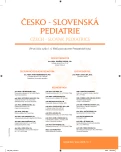The influence of menarche of high cholesterol level in adolescent girls with familial hypercholesterolemia
Authors:
J. Hyánek 1; L. Dubská 1; V. Martiníková 1; J. Privarová 1; H. Přindišová 2; M. Zagyiová 1; L. Táborský 1
Authors‘ workplace:
Metabolická ambulance a Oddělení klinické biochemie, hematologie, imunologie, Nemocnice Na Homolce, Praha primář MUDr. L. Táborský
1; Radiodiagnostické oddělení, Nemocnice Na Homolce, Prahaprimář prof. MUDr. J. Vymazal, DrSc.
2
Published in:
Čes-slov Pediat 2013; 68 (1): 12-19.
Category:
Original Papers
Overview
Menarche (first menstruation hemorrhage) due to increasing levels of sexual hormones decrease the total cholesterol level (TCH) in some girls with familial hypercholesterolemia (FH) up to 3–5 mmol/l. In the past this experience resulted in recommendation to begin with the pharmacological therapy of FH in girls only after menarche. Our experience however does not correspond to that.
In 20 girls at the age of 10–16 years diagnosed FH we had a chance to follow cholesterolemia in the course of their pharmacological therapy and in the last 20 years we observed the following relations to menarche:
- a) In 70% of patients with marked entry hypercholesterolemia (>8.0 mmol/l TCH) the decreased levels were fund to be only transitory and after several menstruation ccles the level of TCH returned to original high levels if the pharmacological therapy was not applied.
- b) In 30% of patients with inconspicuous hypercholesterolemia (6–8.0 mmol/l) half of them experienced lasting normal level of TCH which did not require pharmacological treatment. In the remaining 15% of girls with inconspicuous TCH level gradually increasing after several menstruations cycles to previous high levels and these patients require permanent pharmacological, optimally combined, therapy (ezetimib + statin).
Conclusion:
Our experience suggests a new recommendation to begin pharmacological therapy of FH in selected female patients with marked form of HC documented by mutation of LDL-receptor as early as in 8 years of life in the same was recommended in boys.
Key words:
familial hypercholesterolemia, menarche, high cholesterol level changes after menarche, adolescent girls
Sources
1. Hořejší J. Dětská gynekologie. Praha: SPN, 1990.
2. Cibula D. Hormonální substituční léčba. Remedia 2001: 321–333.
3. Marek J, Hána V, Kršek M. Jak ovlivňují kortikoidy, růstový hormon a estrogeny lipidy a aterosklerózu. Vnitř Lék 2007; 53: 386–390.
4. Blankenhorn RH, Hodis HN, et al. Arterial imaging and atherosclerosis reversal. J Arterioscl Thromb 1994; 14: 177–189.
5. Baass A, Dubuc G, Trembley M, et al. Plasma PCSKG is associated with age, sex,and multiple metabolic markers in a population-based sample of children and adults. Clin Chem 2009; 55: 1637–1645.
6. Gidding SS, Dennison B, Birch LL, et al. Dietary recommendations for children and adolescents. Consensus statement from the American Heart Association. Circulation 2005;112: 2061–2075.
7. Gidding SS. The rationale for lowering serum cholesterol levels in American children. Amer J Dis Child 1993; 147: 386–398.
8. Nařízení vlády ČR č. 149/1994 Sb. Zdravotní řád.Věstník MZ ČR, část 7, par. 4, písmeno c.
9. Newman TB. Problems with the report on the expert panel on blood cholesterol levels in children an adolescents. Arch Pediat Adolesc Med 1995; 149: 241–247.
10. Stožický F, et al. Metodické doporučení pro selektivní screening a léčbu dětí a adolescentů s dyslipidemií se zaměřením na prevenci aterosklerózy. Čes-slov Pediat 1998; 53: 186–189.
11. Šamámek M, Urbanová Z. Ateroskleroza u dětí a adolescentů. Praha: Grada, 2005.
12. Urbanová Z, Šamánek M, Češka R. Diagnostika a léčba dyslipidemií u dětí a dospívajících. Doporučení výboru ČsATS. Čes-slov Pediat 2008; 63: 164–172.
13. National Cholesterol Education Program. Report of the expert panel on blood cholesterol levels in children and adolescents. Pediatrics 1992; 89: 484–515.
14. Hyánek J, et al. 10leté zkušenosti s medikamentózní léčbou familiární hypercholesterolemie u dětí a adolescentů. Čes-slov Pediat 2006; 61: 404–412.
15. de Jongh S, Ose L, Szamosi T, Gagne C, Lambert M, et al. Efficacy and safety of statin therapy in children with familial hypercholesterolemia: a randomized, double-blind, placebo controlled trial with simvastatin. Circulation 2002; 106: 2231–2237.
16. Rodenburg J, Vissers MN, Wiegman A, van Trot-senburg VP, et al. Statin treatment in children with familial hypercholesterolemia. The younger, the better. Circulation 2007; 116: 664–668.
17. Wiegman A, Hutten BA, deGroot E, et al. Efficacy and safety of statin therapy in children with familial hyper-cholesterolemia: a randomized controlled trial. JAMA 2004; 292: 331–337.
18. Hyánek J, Pehal F, Dubská L, et al. Praktické zkušenosti s rutinním využitím vybraných necholesterolových sterolů (zvláště lathosterolu a kampesterolu) při diferencování dietní a medikamentózní léčby hypercholesterolemií u dětí a adolescentů. Klin Biochem Metab 2011; 19 (40): 136–142.
Labels
Neonatology Paediatrics General practitioner for children and adolescentsArticle was published in
Czech-Slovak Pediatrics

2013 Issue 1
Most read in this issue
- A massive pulmonary embolism as a first symptom of nephrotic syndrome in 18-years old female patient
- Importance of early diagnostics of inherited metabolic disorders in neonatal age
- Somatic development of the child and injury incidence during the pubertal spurt – new knowledge of the correlation between growth dynamics and injury risk in the present population of children
- Analysis of risk factors concerning suicidal behavior in childhood and adolescence
